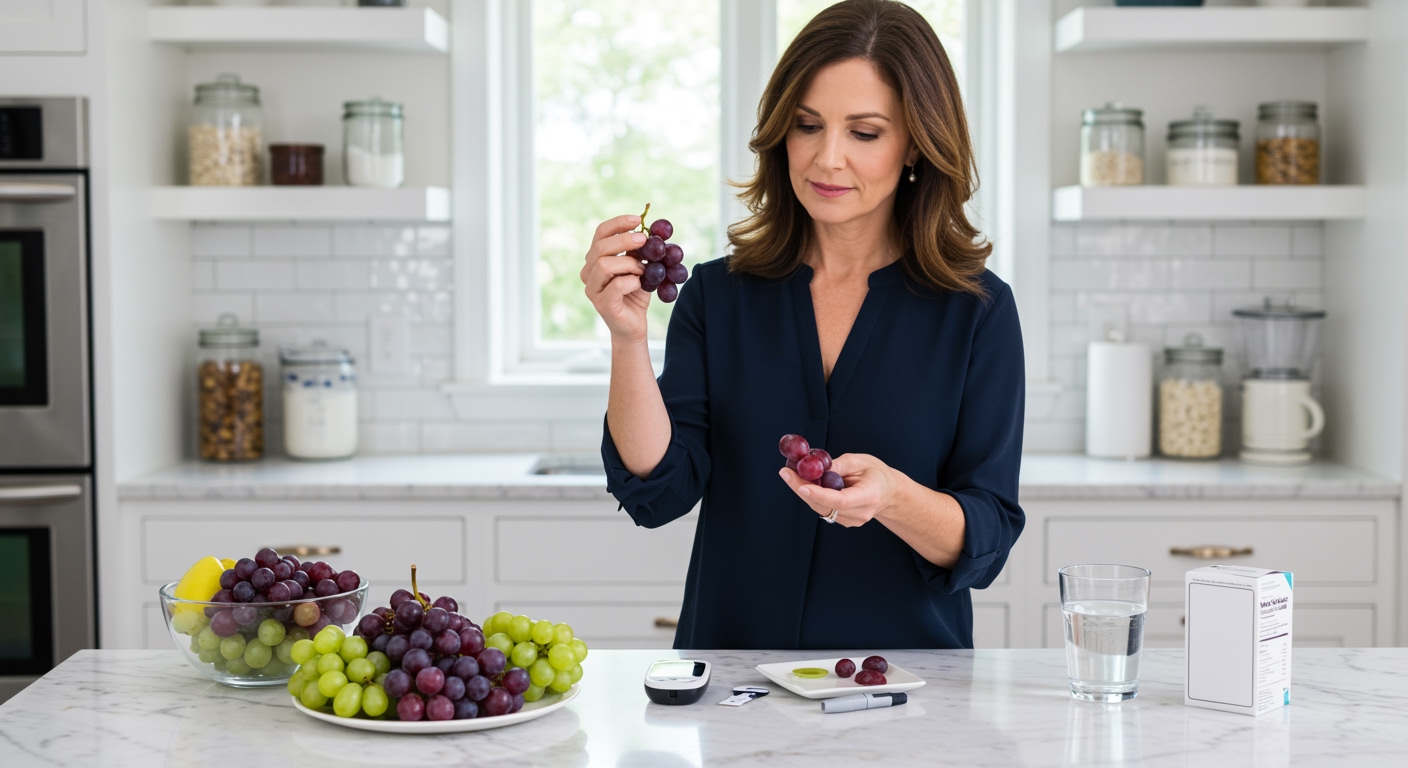✪ Key Takeaway: Grapes can be safely enjoyed by people with diabetes when eaten in controlled portions and paired with protein or healthy fats.
Introduction
You reach for a handful of grapes and suddenly pause, wondering if these sweet little orbs will send your blood sugar soaring.
This concern makes perfect sense because grapes taste incredibly sweet and contain natural sugars that can affect your glucose levels.
Hi, I’m Abdur, your nutrition coach and today I’m going to explain exactly how grapes affect blood sugar and share the best strategies for enjoying them safely with diabetes.
Do Grapes Raise Blood Sugar Levels?
Yes, grapes do raise blood sugar levels because they contain natural fructose and glucose that your body absorbs quickly.
One cup of grapes contains approximately 16 grams of sugar, which can cause a moderate spike in blood glucose within 30 minutes of eating.
The glycemic index of grapes ranges from 46 to 59, placing them in the low to moderate category for blood sugar impact.
When you eat grapes, the fructose gets processed by your liver while glucose enters your bloodstream directly, causing your pancreas to release insulin to manage the sugar surge.
The fiber content in grapes helps slow down sugar absorption slightly, but it’s not enough to prevent blood sugar elevation completely.
✪ Pro Tip: Eat grapes with a handful of nuts to slow sugar absorption and minimize blood sugar spikes.
What Makes Grapes Different From Other Fruits?
Grapes have a unique sugar composition that sets them apart from many other fruits in terms of diabetes impact.
Unlike apples or berries, grapes contain almost equal amounts of fructose and glucose, creating a dual pathway for sugar processing in your body.
The concentrated sweetness in grapes comes from their high sugar-to-fiber ratio, making them more likely to cause rapid blood sugar changes.
Grapes also lack the protein and healthy fats found in some other fruits, which means they provide no natural buffering effect against sugar absorption.
The small size of grapes makes portion control challenging because people often eat them mindlessly, consuming more sugar than intended.
However, grapes contain powerful antioxidants like resveratrol and flavonoids that may help improve insulin sensitivity over time.
✪ Fact: Red and purple grapes contain more antioxidants than green grapes due to their anthocyanin content.
How Much Grapes Can You Eat With Diabetes?
The safe portion size for grapes with diabetes is typically 15-20 grapes or about half a cup, which equals one carbohydrate serving.
This portion contains roughly 15 grams of carbohydrates, which fits within most diabetes meal planning guidelines for a fruit serving.
Your individual tolerance may vary based on your medication regimen, activity level, and overall blood sugar control.
Testing your blood sugar before and after eating grapes helps you understand your personal response and adjust portions accordingly.
Eating grapes as part of a balanced meal rather than alone helps minimize spikes by slowing digestion and sugar absorption.
People with well-controlled diabetes may tolerate slightly larger portions, while those with unstable blood sugar should stick to smaller amounts.
✪ Note: Count grapes individually rather than estimating portions to maintain accurate carbohydrate tracking.
When Is The Best Time To Eat Grapes?
The optimal time to eat grapes with diabetes is during or immediately after physical activity when your muscles can quickly use the glucose.
Eating grapes as part of breakfast or lunch works better than having them as an evening snack because your insulin sensitivity is typically higher earlier in the day.
Avoid eating grapes on an empty stomach, as this can cause rapid blood sugar spikes without any buffering from other nutrients.
Pairing grapes with protein sources like cheese or nuts creates a more balanced snack that prevents dramatic glucose fluctuations.
If you take diabetes medication, coordinate grape consumption with your dosing schedule to ensure adequate insulin coverage for the carbohydrates.
Pre-meal grapes can actually help with portion control by providing some satiety, but monitor your total carbohydrate intake carefully.
✪ Pro Tip: Freeze grapes for a slower-eating experience that naturally controls portion sizes and satisfaction.
Are There Any Benefits Of Grapes For Diabetes?
Despite their sugar content, grapes offer several health benefits that may actually support diabetes management when consumed appropriately.
The resveratrol in grape skins has been shown to improve insulin sensitivity and reduce inflammation associated with diabetes complications.
Grapes contain flavonoids that may help protect blood vessels from damage caused by high blood sugar levels over time.
The antioxidants in grapes support overall cardiovascular health, which is crucial for people with diabetes who face increased heart disease risk.
Some studies suggest that moderate grape consumption may help improve glucose metabolism at the cellular level through various bioactive compounds.
The potassium in grapes supports healthy blood pressure, addressing another common concern for people managing diabetes.
✪ Fact: Grape seed extract supplements show promise for improving insulin resistance in research studies.
The Bottom Line
Grapes can absolutely be part of a healthy diabetes diet when you eat them mindfully and in appropriate portions.
The key to enjoying any food with diabetes is understanding how it affects your body and planning accordingly.
I’d love to hear about your experience with grapes and blood sugar management, so please share your thoughts or questions in the comments below.
References
At NutritionCrown, we use quality and credible sources to ensure our content is accurate and trustworthy. Below are the sources referenced in creating this article:
- Signos: Grape Glycemic Index
- PubMed: Grapes and Health Research
- Healthline: Low Glycemic Fruits for Diabetes
- Nutrisense: Do Grapes Raise Blood Sugar Levels





